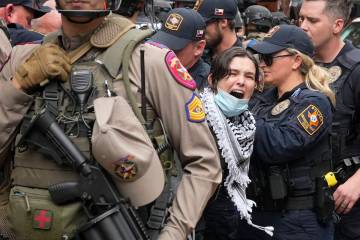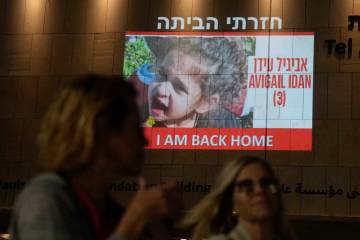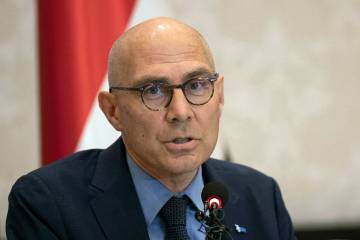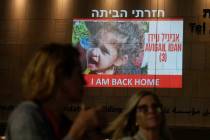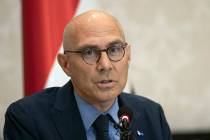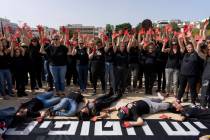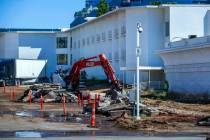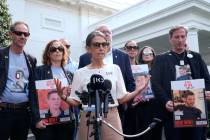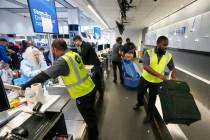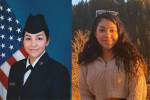R.G. ‘Zack’ Taylor
No streets or buildings on Nellis Air Force Base are named after Maj. Gen. R.G. "Zack" Taylor, whose tenure as a wing commander was from the summer of 1966 through December 1969. Not that he would have coveted such recognition. More often than not that honor signifies a flying career cut short.
Such was the fate of base namesake, William Harrell Nellis, Las Vegas High School Class of 1936. Nellis met his fate two days after Christmas 1944, when he was hit by ground fire while strafing a German convoy near Bastogne, Belgium. Nellis' plane burst into flame and plunged to the ground.
Taylor also fought in the skies over Europe. He escaped the fate which might have memorialized him on a base somewhere near his home at Durham, N.C. Instead he tallied six aerial victories against the Luftwaffe to become an "ace." He fought again in Korea and trained young pilots for Vietnam.
Several men before and after Taylor's tenure helped shaped Nellis history. Dr. Cate Willman, Air Warfare Center historian, points out figures such as Army Maj. David M. Schlatter, a staff officer with the Western Center, Army Air Corps Training Command at Moffet Field, Calif. It was Schlatter who in 1940 flew around the Southwest looking for airfields at which to establish aerial gunnery schools.
"The Army could clearly see that war was on the horizon," said Willman. "Europe was already engulfed in World War II and we were clearly going to enter it soon. To prepare, the Air Corps, emerging from the Depression years, needed to develop new ways of fighting."
When Schlatter climbed out of his aircraft in Las Vegas on Oct. 1, 1940, it was to discuss establishing an aerial gunnery school.
"They needed these schools because military doctrine, then, was predicated on the ability of the bomber to defend itself against attack, which meant that it would go in to a target, drop its bombs and come home, all without any fighter escort. You needed gunners to do it," Willman said.
Schlatter's visit was successful and the Army leased 160 acres in Las Vegas. Lt. Col. Martinus Stenseth became the first commander and set up his headquarters in the basement of the Las Vegas Post Office.
That airfield metamorphosed many times in the years between Stenseth and Taylor. In late August 1966, just days before Taylor became the first commander of the U.S. Air Force Fighter Weapons Center, 18-year-old Alex Tharp, a former Rancho High School student, was hit with a sniper's bullet. He became the 10th Las Vegas son to die in Vietnam.
Air Force pilots were also dying in Vietnam. Too many, and Maj. Richard "Moody" Suter wondered why.
In Korea, the U.S. Air Force kill ratio over the enemy was at least 10 to one. In Vietnam it was only half that, and pilots were also being shot out of the sky in significant numbers by anti-aircraft fire and surface-to-air missiles. Suter asked every fighter pilot, "Why?" What was the problem? How could it be fixed?
Suter studied the problem and proposed a solution. That solution, in one word, was realism. That realism would eventually become the "Red Flag" training exercises.
In Red Flag, portions of the 3.1 million-acre Nellis bombing and gunnery range, become enemy territory. "Aggressor" pilots, flying specially equipped F-16C fighters, used the tactics and maneuvers of potential enemies. On the ground missile sites seek, track and try to electronically "shoot down" the good guys in the most realistic air combat training ever devised.
Visionaries like Suter conceived Red Flag, and electronic warfare experts like Lt. Col. Donald Simanski made it happen. Simanski had more than 100 combat missions over North Vietnam. He and his peers ensured that simulated SAMS (surface to air missile sites) behaved like the real thing. Every Iraqi missile site taken out in Desert Storm -- and since then in actions in Iraq, Bosnia and Kosovo -- is a testament to the Nellis Red Flag exercises. Veteran pilots often swear the air war with Iraq was won in the skies over Nevada.
Taylor's contribution to Nellis was not the vision of Suter or the expertise of Simanski, but a historical situational awareness, coupled with an ability to lead and political savvy. He would use those traits to capitalize on a potential for Nellis first seen by Schlatter. Taylor's timely contribution would elevate the status of the base within the Air Force and permit an ever-growing number of training missions over the past 30 years.
That status has kept Nellis growing, even while the rest of the Air Force down-sized.
America had been at war in Vietnam for two years, when Taylor took command of the 4520th Combat Crew Training Wing at Nellis. When pilots would rotate back from combat units in Southeast Asia, some of the best of the best would become Fighter Weapons School instructors at Nellis. There they would teach the best young pilots from other combat units to become experts in the fighter they flew and all the weapons it used.
One of these "best of the best" instructors was Maj. Jim Abraham, who specialized in the F-4 Phantom, the workhorse of the Vietnam War. Taylor had his choice of aircraft to fly while at Nellis and he naturally chose the Phantom. Abraham was assigned to check the general out in the hot fighter.
"General Taylor had never been in TAC before," noted Abraham, referring to the Tactical Air Command, which specialized in fighter units. "But the first time we sat down to talk flying I knew that this guy was a fighter pilot through and through. It made my job very simple."
Because TAC had a rule that no general officer could fly alone, someone needed to fly with Taylor whenever he went up and Abraham got that job, too.
Soon after arriving at Nellis the general wanted an orientation of the war in Vietnam.
"When Taylor learned what we were doing he was excited that Nellis was directly involved in the war effort and he wanted to find out first hand what kinds of problems the pilots over there were facing. So we packed up and went to Vietnam," said Abraham.
Taylor and Abraham visited every major air base in Thailand and Vietnam. "We would go meet with the wing commanders and as soon as they realized General Taylor was a real fighter pilot who knew what they were up against, they would gather all the pilots in the wing to talk with us. The general would have me brief them on the latest munitions delivery techniques we were developing at Nellis. Then he would ask them what problems they were facing and how could Nellis do a better job of keeping them up with the new techniques.
"We spent three weeks over there and on the way back the general began writing another briefing that he would give at 12th Air Force and TAC headquarters about what he learned. He wanted to make sure Air Force knew that Nellis was already making a positive contribution to the war effort and was going to make more," said Abraham.
Abraham's most memorable trip with Taylor, though, was to the Pentagon. The concept of a Fighter Weapons Center was being discussed. Leaders realized technology was outpacing the ability of the combat units to effectively deal with it.
Taylor's 4520th Combat Crew Training Wing was seen as a core for a fighter weapons center, but nobody had really stepped forward to name or sell Nellis as the home for the center.
"Zack said `Why not Nellis?' " Abraham related. "He said, `We have the Fighter Weapons School, the best flying weather and the ranges. What could be better than doing it here?' "
The great Nellis flying weather was a result of the base being in the desert Southwest. In those days, that made it just a wasteland in the minds of many Washington politicians and generals. "Zack made a point of making sure that Nevada's senators knew how important the center would be and how valuable to Nevada," said Abraham.
Years later, while chairman of First Western Savings, Taylor quipped that his strategy to bring the center to Nevada was simple: "Use a Bible and if that doesn't work, use a Cannon." Nevada's senators, at the time, were Alan Bible and Howard Cannon.
The senators could take care of the politics, but they couldn't sell Nellis to the Air Force chain of command. That was Taylor's job. "I remember watching him preview his briefing for the base staff in his office. It was masterful. He covered all the bases and he was committed."
Taylor believed in practice. Sophia Hesbon, who worked in the Nellis Information Office, recalls, "We once hosted a dinner on base for Las Vegas civic leaders and General Taylor had the whole program scripted. ... He even made the chaplain come and practice his prayer. Everybody got a kick out of that."
By the time Taylor briefed the Air Staff at the Pentagon there were no questions left to ask. Abraham remembers that flight to Washington for more than the briefing.
"We had planned an air refueling," says Abraham. "The general had just recently checked out in the F-4. It was night time, and the weather was bad. We came down below the weather and met up with the tanker and all Zack said was, `If I can't get on it Jim, can you refuel from the back?' I said, `Oh yeah, I've done it before.' So he pulls up on the tanker, hooks up with no problems and takes on a full load of fuel. We drop off and head for Andrews. He had never been on a tanker before, much less at night. It was amazing."
When Taylor and Abraham arrived over Andrews the weather was bad there, too. "You can't see, so the guy on the ground ... watches you on radar and talks you down to the runway. Zack was amazing. Once the tower got him lined up with the runway the first time, all the guy said was on glide path, on heading, on glide path, on heading. No corrections whatsoever all the way to landing," said Abraham.
On Sept. 1, 1966, the Tactical Fighter Weapons Center was activated and assigned to the 12th Air Force. Before Taylor transferred from Nellis in 1969 the base payroll had nearly tripled with the addition of two wings.
But Taylor's significance to Las Vegas transcends the growth of the base. Following his retirement at Scott Air Force Base, Ill., in 1971, Taylor and his wife Beth wasted no time in returning to Las Vegas.
Frank Scott, former owner of the Union Plaza, remembers giving Taylor his first civilian Las Vegas job there. "I got to know him when he was out at the base because I was very interested in flying," says Scott. Taylor had only been in the Plaza job six months when Scott saw his potential and moved him to another business interest, First Western Savings. Taylor would retire from First Western 20 years later as chairman of the board.
During and after that time he remained a booster for Nellis.
"He would always come out to the base to meet the new commanders and he would personally take them around town to introduce them to all the people who could help the base," said Hesbon.
When Taylor became active in the Las Vegas Chamber of Commerce he was instrumental in building strong ties between the chamber and the base. By 1975 he was president of the chamber. Long-time chamber scribe, Ken O'Connell, credited many of the chamber's accomplishments in the 1980s to Taylor's planning.
Chamber work only scratched the surface of Taylor's community involvement. The National Conference of Christians and Jews named him Distinguished Citizen of the Year in 1976. He served as president of United Way of Southern Nevada, was on the board of directors of the Boulder Dam Area Council of Boy Scouts of America, was a trustee of the Nevada Development Authority, and was appointed in 1983 to the Nevada Economic Development Commission. Taylor had dropped out of Duke University before graduation to play his part in World War II; in 1983 he got to wear the commencement robe when UNLV gave him an honorary doctorate.
Taylor died on Sept. 17, 1997, after attending one of the events commemorating the 50th Anniversary of the Air Force.
Part III: A City In Full







